Indian contemporary artist Savia Mahajan talks about devising her own methods to work with her material of choice, paper clay.
“What is beauty really, but a way of looking; a fresh flower or a rotting carcass, all is a continuum, a series of constant creation and constant destruction, with intermissions.”
Indian contemporary artist Savia Mahajan.
Featured image: Colonies, 2016. Pen and ink, stained with pomegranate skin and tea extracts on Washi Paper. 13.5 x 25 inches. Indian contemporary artist Savia Mahajan.
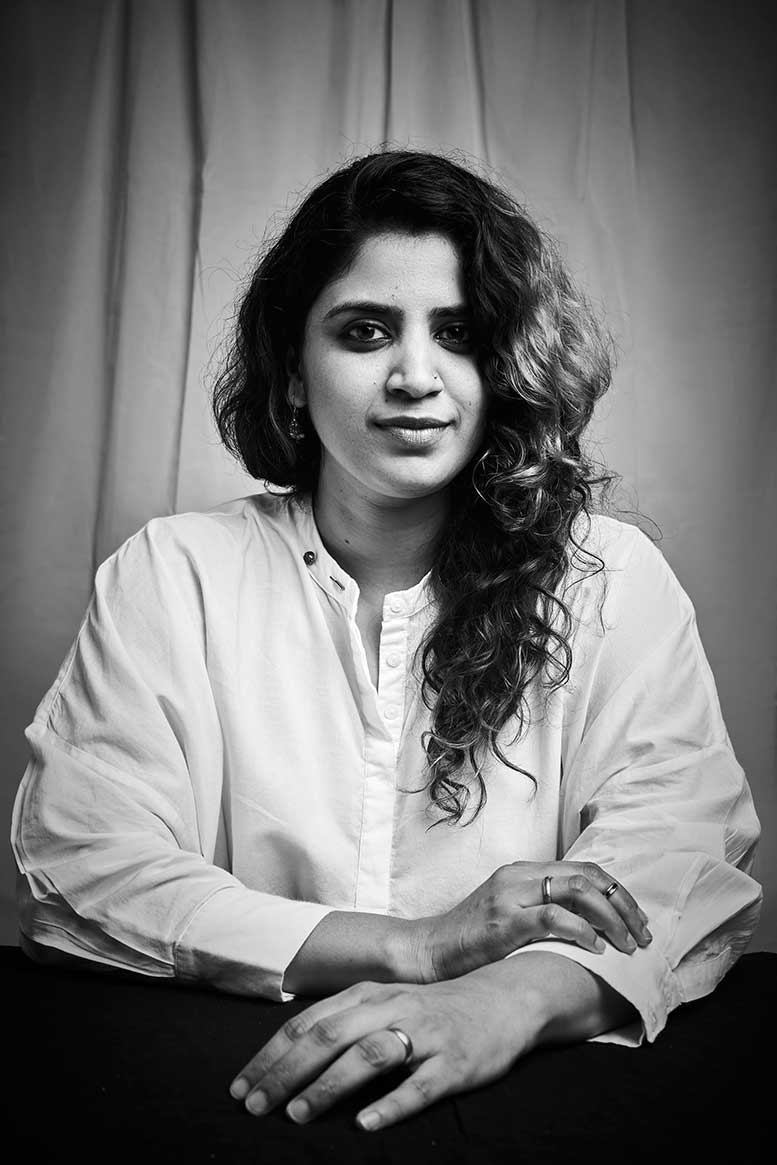
Indian contemporary artist Savia Mahajan. Portrait courtesy TARQ.
Please tell us a little about yourself.
I have been inclined towards art since childhood. My mother worked for an Indian colour manufacturing company, hence access to colours was easy. And due to the discounted prices it was available to me more than other children. I had all types of new mediums and art material at any given point to go crazy with.
During art school, I worked part time, making hand painted samples and colour swatches of new materials from the company, sent by the management and earned decent pocket money. I realised much later that my father, too, contributed majorly towards my exposure to art. While in school, he took me for my first ever studio visit to an artist and illustrator’s work space and to a clay modelling workshop. These workshops are very popular in Mumbai. They make large scale Ganesha idols before the festivals, only to be immersed at the end of the celebrations. That was my first introduction to the world of clay.
I come from a family of great cooks. My parents cooked and made cuisines from their native places. They taught me the importance of buying fresh produce. Maintaining recipes, smell of spices, the way the food looked and was presented; were all very important and celebrated in my household. It was through food that we stayed close as a family. I grew up to understand that food is an instant form of art. Now looking back, I realise I follow a lot of it in my artistic life. Maintaining recipes books of clays and minerals and to put it simply, what is ceramics but an ancient method of cooking clay.
What brought you to the world of contemporary art ?
I was a quiet child with an eerie sense of calmness. For me, art was a way to have a voice and space to express anything, without anyone questioning what or why. As a teenager, I went through this intense existential period with a longing to know the purpose of living and turmoiled by the sense that the world is large, what lies beyond and what is the purpose of someone as insignificant as me. All these early experiences stayed with me and somewhere streamed in my system. The inclination to create as an expression grew stronger and when the time came to choose, I decided to study fine arts.
I studied Painting and majored in Print-making. For nine years, I painted in a very distinct folk and aboriginal style. In 2009, I felt a shift, an urge to work and build with my hands and a yearning to work with natural materials. I followed my instincts and began experimenting at a local pottery studio in Mumbai. The space was a thriving unit of pottery production, kiln making, ceramic glazes and mould-making. I was exposed to and learnt several techniques such as clay making, glazing composing and firing methods. I studied and got hands-on experience about the vast and versatile possibilities in ceramics. Since 2014, I began building a serious body of work. I presently, work out of my own ceramics studio in Mumbai.
My practice includes using clay and drawings as my two primary mediums.

“I am interested in the darkness that we hold within us as containers, for me speaking about death is as beautiful and alluring as life itself.”
What is the primary role of an artist? How do you describe yourself in the context of challenging people’s perspectives via your work and art?
The primary role of an artist is to be alive, intuitive, feel deeply. However painful, be willing to go inwards and extract all that is ugly, beautiful, uneasy, malefic and tender; and to make it known and reveal it unabashedly. It is to be a force so potent that it is hard to ignore.
With regard to challenging peoples perspectives, I am interested in the darkness that we hold within us as containers. For me, speaking about death is as beautiful and alluring as life itself.
Also, what is beauty really, but a way of looking. A fresh flower or a rotting carcass, all is a continuum, a series of constant creation and constant destruction, with intermissions.
Through my work, as I pose these questions to myself, I try to resolve them for myself, heal in way by creating the work that I make. And if my quest is honest enough, it definitely resonates with people, as pure emotions are always universal and relatable.
How do you deal with the conceptual difficulty and uncertainty of creating work?
Being on the edge and not knowing, chasing a phantom, a whim, an epiphany is what makes creating art a process of pure torture and deep joy. During those times, I go through outbursts of creating and then I fear there are long or short pauses. It is uneasy but it is all needed and I have learnt to fill those pauses with reading, writing, and collecting. You try to push out something from inside of you by looking in a different direction for a bit; only to return back to the point you left at and find something of potential right there. Also, I bank on failed works, diary notes and older works that always have hidden clues leading to a new direction.
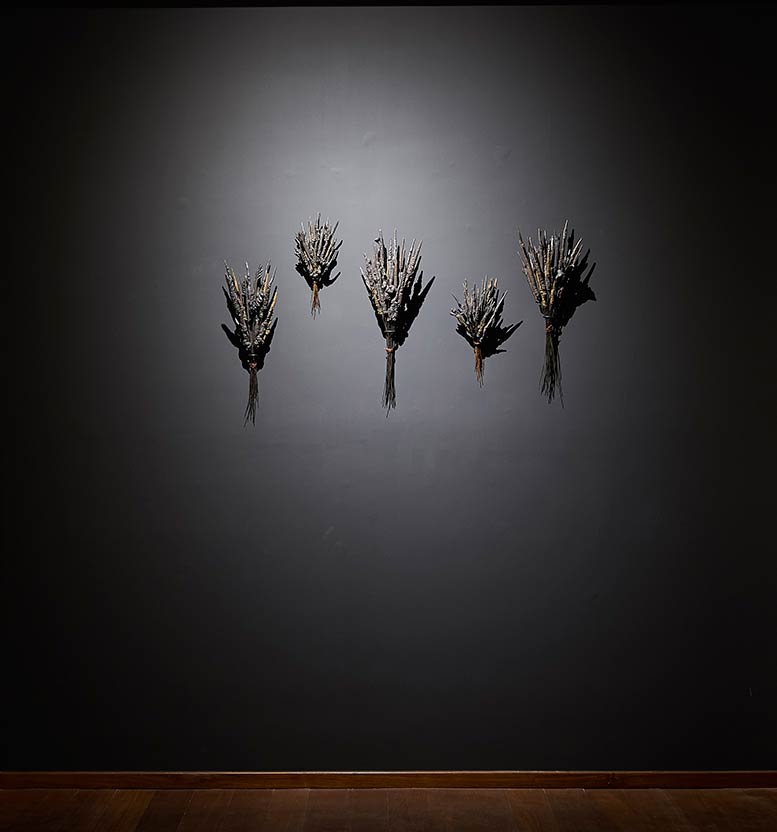
Installation view. Osmosis. Resurgō, Ground floor 2019. Indian contemporary artist Savia Mahajan. Image courtesy TARQ.
Is there any topic lately that you would like to be mentored on?
Indigo dyeing is something that is attracting me for a while now. I am very keen to study or work under indigenous master artisans from India, Japan or Africa. Understanding and executing the alchemy of indigo is something that will add to my already material oriented practice.
Let’s talk about the evolution of your practice over the years. Tell us about your commitment to your current medium of art.
Over the years, I developed a few of my own techniques and working methods. I work with paper clay, not used as much in traditional pottery but a lot in contemporary art, pottery and ceramics. It is known specially for its tensile strength and to make larger works. The paper fibres prevent the clay from cracking and used for mending mild cracks on wet and fired clay pieces.
I have devised my own methods to work with paper clay, using paper sheets, books, paper off cuts and several organic additions to the clay. I petrify objects and as a technician, I maintain the correct clay composition, consistency and firing temperatures. Slowly, I am building a library of samples with natural earth materials that can be fired at different melting points and can yield colour or texture or both.
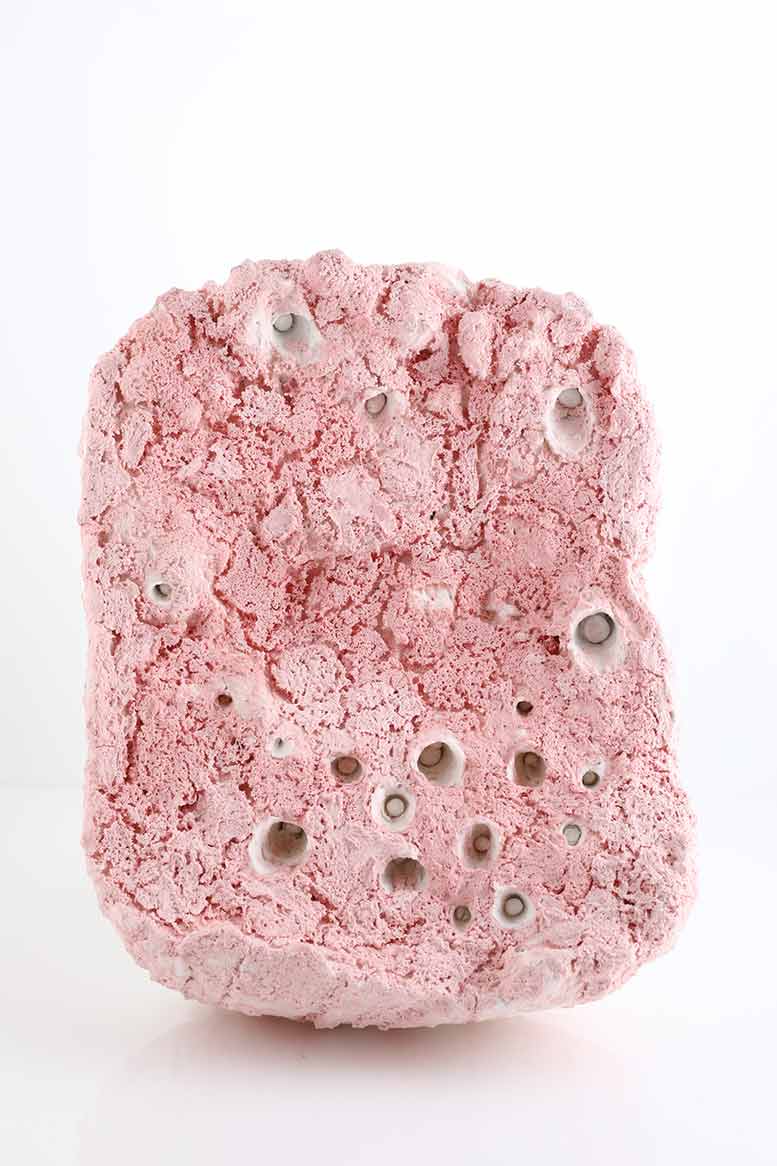
Liminal entity 1, 2016. Porcelain Paper Clay and Stain Base Slip Fired at 1250°C. 4 x 10.5 x 13.5 inches. Indian contemporary artist Savia Mahajan. Image courtesy TARQ.
Let’s talk about your art career, or if you prefer creative journey. What were your biggest learning and hiccups along the way?
My biggest hiccups along the way have been about finding that perfect balance between being consistent and erratic, both as important as the other.
Being too erratic could not help me build a body of work and be focused while being consistent would give me this boring, mundane feeling of waking up and doing the same thing over and over. The challenge has been to accept both, see its beauty and limitations, let things flow and acknowledge the many versions of yourself and your ways of working.
My biggest learning has been in terms of letting-go of comparisons and honouring my own path, whatever that may have been and whichever way I arrived at something. Each one’s way forward is never the same and that is what makes it authentic and unique.

Liminal Occurrence, 2018, detail. Porcelain Paper Clay, Luffa Fibers, Cotton Rope, Cotton Thread, Stain Based Slip, Rust, Calcium Carbonate Based Glaze. Fired at 1250°, re-fired at 750°. Installation Dimensions Variable (Approximately 15ft x 9ft)
Courtesy: Works specifically created for the 1st Indian Ceramics Triennale-Breaking Ground, 2018. Copyright: Copyright Indian contemporary artist Savia Mahajan, 2018.
How does your audience interact and react to the work you put out into the world? What are you looking for when you look at other artists’ work?
I have seen that the works I make, firstly bring about a curiosity of how it is made and later the subject of loss, death or transformation hit. I have observed some withdrawing from the work while others taking the experience of my art along with them. The important thing is that it stirs the viewer one way or the other during their individual experience.
When I am looking at other artists’ works, I am always looking at how they feel or think what have their life experiences been. And later, I begin to observe and study their mediums, materials to understand eventually how they distil and arrive in the most sophisticated manner with their art. For instance, with Yayoki Kusama, the sense of obsession and meditativeness connects with her childhood hallucinations and her obsessive compulsive behaviour mirrors in all her vivid works.
Which shows, performances and experiences have shaped your own creative process? Who are your maestros?
With sculptor, Wolfgang Laib and his past with studying medicine and moving toward beliefs in Taoism and zen philosophy; how it subtly reveals through his ephemeral art. This knowledge is very crucial to me as a viewer and it adds a hundred folds to know the journey when I actually experience their art.
To name a few shows and performances that have influenced me: the retrospective works of Yayoki Kusama at the Centre Pompidou Paris in 2011; Anish Kapoor’s‘Shooting in the corner’ at Mehboob studio in Mumbai and the continuation of the same show in National gallery of Modern Art in Delhi: seeing the very sensitive pigment pieces in 2010and thenseeing the same work ‘Shooting in the corner’ and ‘Dirty Corner’and the large scale work ‘Vortex’at the Palace of Versailles in 2015; discovering Street artist, Swoon’s wheat paste print tucked in the streets of Hong Kongin 2019; the Dali Theatre Museum in Figueres, Spain in 2015 and Himmat Shah’s retrospective spanning six decades of work ,‘The Euphoria of Being’, at the Jawahar Kala Kendra, Jaipur in 2018.
Whose journey would you want to read about?
I would want to read about the journey of Caledonia Curry (when she writes her biography) famously known as the street artist ‘swoon’. I feel a kinship to her life of growing up with addict parents and the circumstances she grew up in. Having had a childhood of growing up in a unsettled environment with an addict parent, all through my childhood and teens. I chose to be an empath, an observer and an activator towards my father’s transformation from addiction to sobriety. Hence I feel a kinship and relatability towards Swoon’s life lessons. I admire the way she articulates her sufferings and fears so beautifully, weaving them to uplift viewers and leave a strong impact through her work in multiple mediums. Others on my wish list are Pablo Picasso’s Ceramics at Vallauris in France; Eva Hesse’s sculptures and Wolfgang Laib’s Pollen work.

Lithified lives 16, 2014. Ceramic, china clay, cobalt [Co] and porcelain stain based slips. Fired at 1220°C and re-fired at 1250°C. 11 x 8.6 x 1.7 inches. Indian contemporary artist Savia Mahajan. Image courtesy TARQ.
What was your first sale? Do you handle the commercials yourself or is it outsourced?
My first sale was in my final year of art school, where I sold two of my drawings to a visiting Swiss guest at my artist friend’s home. All my commercials are handled by TARQ art gallery, Mumbai.
“The need to be rash and daring with my works pushed me to invest in my own appliances.”
Indian contemporary artist Savia Mahajan.
Biggest professional / creative risk you’ve taken. What helped you take that risk?
The biggest professional risk I have taken has been to set up my own ceramics studio, with a manual gas kiln in an industrial space in Mumbai.
The only thing that helped me do this was an urge to make a bigger body of work and experiment freely as opposed to renting a community kiln from different potters. I had to wait in queue to use the kiln time and again; while that set up had its own advantages; but with the heavily experimental works I was making, I had to be careful all along not to damage rented equipment’s, the need to be rash and daring with my works pushed me to invest in my own appliances.
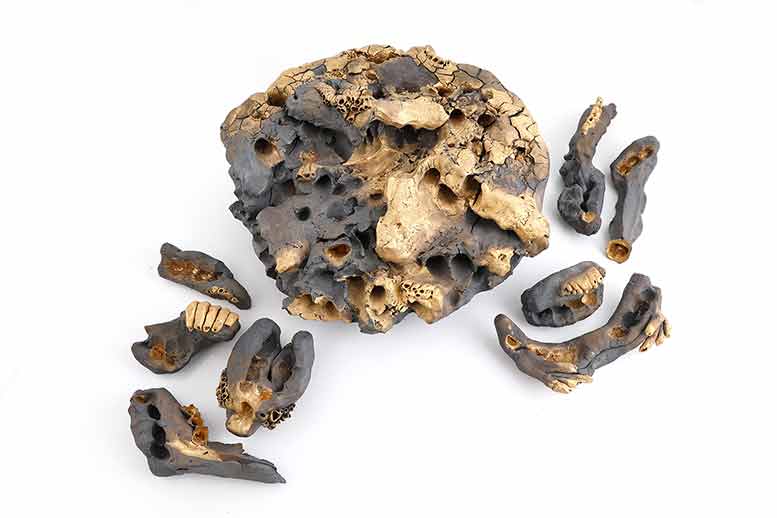
Exhume, 2017. Ceramic, Manganese Dioxide (Mno2) Based Clay Body, Calcium Carbonate [Caco3] Based Glaze And 24 Carat Gold [79au]. Fired at 1200° and re-fired at 750°. 22 x 22 x 4 (Installation Size Variable). Indian contemporary artist Savia Mahajan. Image courtesy TARQ.
Best piece of art advice you’ve received?
The best piece of advice, I have received is, “You are as good as your last work”.
These words have always helped when I am through with a particular work that I am very content with and the work is out there in a public sphere, receiving a good amount of appreciation and fame that comes along with exhibiting. The advice is literally a voice in my head that tells me to keep at it. The triumphs have been enjoyable but one has to stay hungry, keep chipping away, ideating, creating, become a nobody and get back to the practice.
Tell us about your studio, what kind of place is it? Could you describe your usual work day in the studio?
My studio is situated in an industrial belt in the suburbs of Mumbai. The area is filled with small and large scale set ups of printing, plastics manufacturers, corrugated box industries and other production units. The place has a bustling vibe with a constant clockwork of machines at work.
My studio space is seamlessly divided in two sections; an area where I conduct my firings, store my ceramic materials and equipment; and the other half is dedicated to my drawings, where I have my drawing desk, surrounded with my books and reading material. The environment in studio and the way I work is very cyclic . There are days in the month which are chalked out to purely mixing and making paper pulp and clay. The days I actually plan on building and making work are days that don’t have a fixed schedule; I start very early and go until late. This could go on for days until I am done.
Three days are spaced out for firing the clay works, this time table is strictly followed where the first day involves loading the furnace, second day is about firing and running the kiln for thirteen to fourteen hours and finally, the third day is for cooling the kiln.

Exhume, 2017. Ceramic, Manganese Dioxide (Mno2) Based Clay Body, Calcium Carbonate [Caco3] Based Glaze And 24 Carat Gold [79au]. Fired at 1200° and re-fired at 750°. 22 x 22 x 4 (Installation Size Variable). Indian contemporary artist Savia Mahajan. Image courtesy TARQ.
How do you strike a balance between the contradicting motivations: commercial v/s creative? How does your interaction with a curator, gallery or client evolve from the initial interface, to the working-involvement-relationship?
For me, the roles and interaction with a curator, gallerist or client are three very different categories. I feel one’s relationship with the gallery is all about fellowship, faith and respect. It is about working in tandem with each other as they are the bridge that takes you from your studio practice to the existing art system and viewership. The relationship involves necessary realistic conversations apart from your concepts and process sharing as an artist. Hence, there is a transparency and understanding that it is team work towards the benefit of both.
With the curator, it is all about the dialogue; the choice you make as an artist as to how much of an opening or view you can offer into your ongoing processes, the dedicated time you spend in discussing concepts, placements and fleshing out a show together to finally presenting that visual experience and content to the audience.
With a client, it is a choice, it is being in agreement to adjust and tweak your aesthetics, meet them halfway and work with a deadline and site specific format.

Colonies, 2016. Pen and ink, stained with pomegranate skin and tea extracts on Washi Paper. 13.5 x 25 inches. Indian contemporary artist Savia Mahajan.
Are you more of a studio artist or naturally collaborative by nature?
I am more of a studio artist. I love my own space, being surrounded by objects, drawings and the air of my own thoughts; the smells of my materials and the noise of my surroundings and the unfolding of different works and projects in my studio space. However, for the past few years, I have been feeling this urge to collaborate. I think there are many issues and social dialogues on a larger scale that one can bring forth through a collaborative effort. There are many ideas and concepts that stay as a seed in an artist’s diary and can only be cultivated with other creatives’ minds and hands that get involved; and more importantly who are in synergy with each other.
I also like the idea of a heated situation involving crossing boundaries and allowing each other to do so as collaborators. I love that it dissolves the individual. It is a good ego busting exercise in many ways for an artist working single handed and alone most of the time.
How do you feel about commissions?
Along with my own studio practice, I am currently part of a collaborative called the A3 collaboration (artist- artisan-architect). The A-cube collaborative is a tradition in many cultures that date back in history where architects, artists and artisans combine their energies and ideas to create art monuments and movements. Some of the most marvelled sites like the Khajuraho temple, and Ajanta Ellora caves in India came into existence with such combined forces. For centuries, this collaborative culture has been very predominant in India. It is dedicated to reviving some of the lost traditions and values of creative building and sharing.
The primary goal is to work with earth with sustainable materials and traditional techniques. These are cob, rammed earth, laminated vault technique from Catalonia, to name a few. Along with these, all types of waste materials that can fit the ethics, aesthetics and concept of the project at hand. You can learn more about such initiatives by visiting Studio Dot and Art Village.
While commissions are great opportunities, I cannot juggle too many of them, given the material and slow processes I work with. If it can help me explore a scale or new techniques of working and bring in good finances, it is a yes for me. Provided, the client understands the uncertainty, limitations and the time consuming aspects of clay as a medium.
What are you working on now? What’s coming next season?
Ephemeros: lasting only a day, is a new ongoing project. It consists of drawings on human skin that I have started to work on since the Covid -19 pandemic hit the world. The feelings of tackling the spectre of mortality and savouring the ‘NOW’ while it lasts; as death lurks in a new malefic form of an invisible micro-organism. This is one of the works that emerged from a restless imploding feeling during my time in lockdown. It deeply connects with my thoughts on impermanence in an intimate experiential way.
For enquiries contact: press@tarq.in
Instagram
Before you go – you might like to browse our Artist Interviews. Interviews of artists and outliers on how to be an artist. Contemporary artists on the source of their creative inspiration.








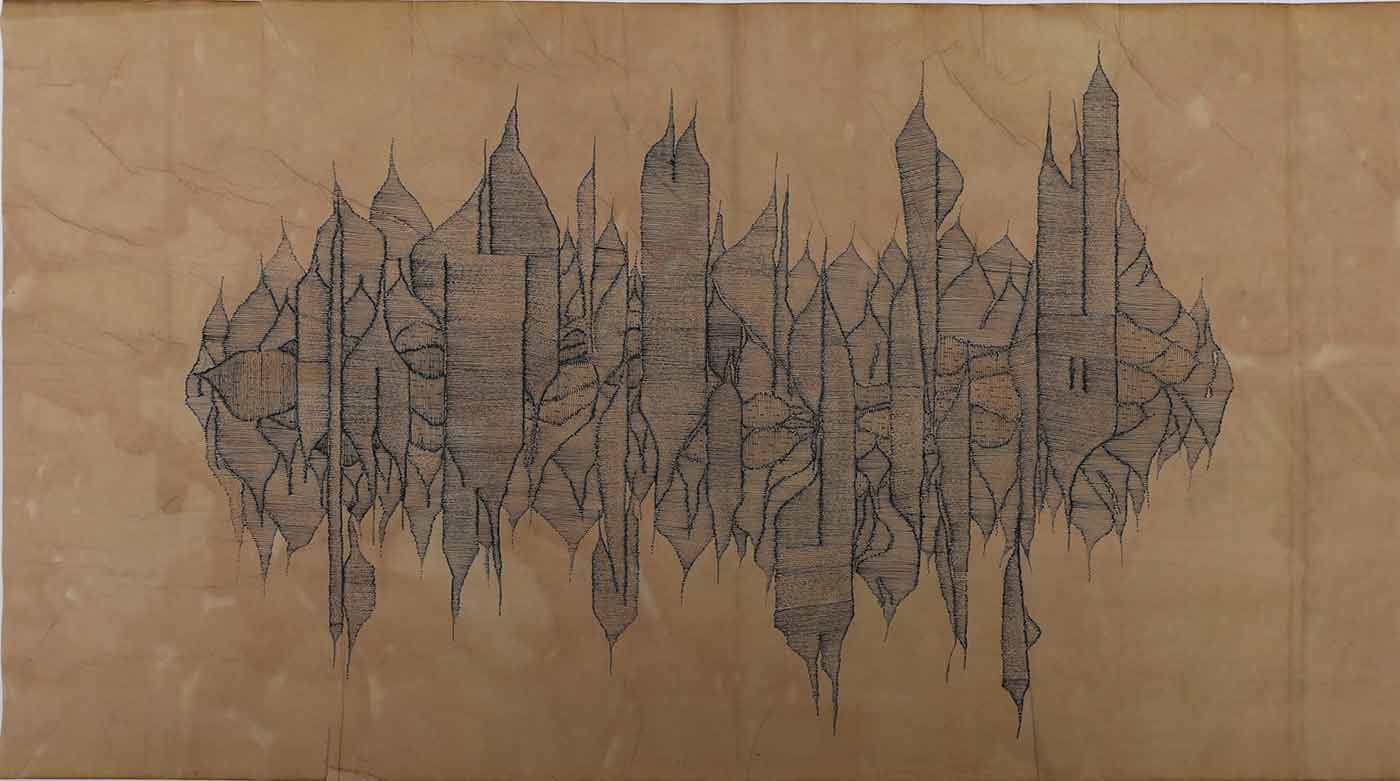



Add Comment